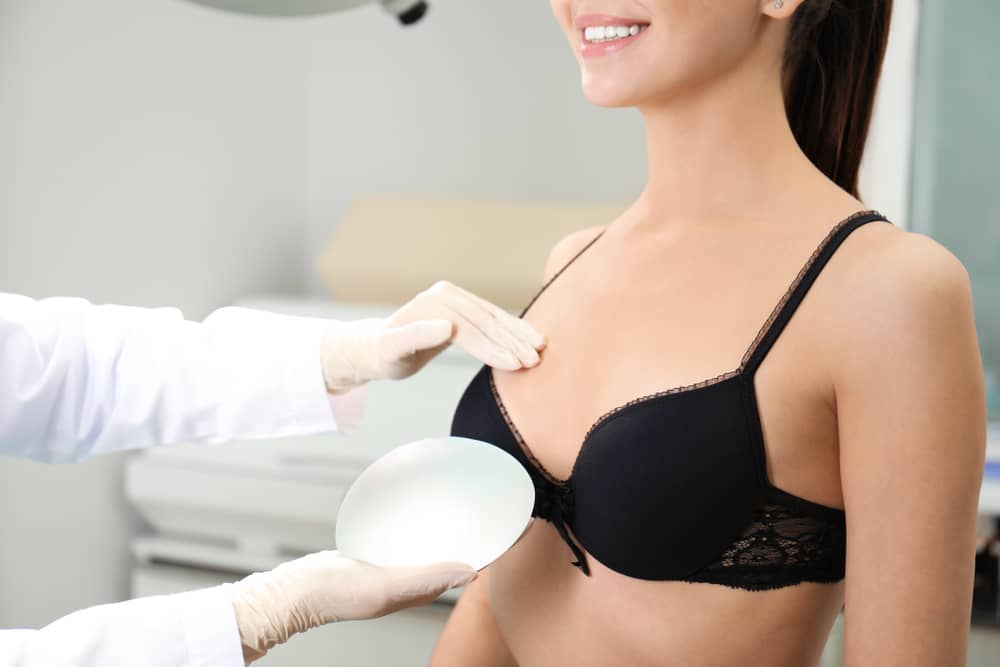Ever looked in the mirror and noticed that your breasts don’t quite match? the right breast may be bigger than the left or vice-versa. You’re not alone. Breast asymmetry is a common concern that many women experience, and it’s often more noticeable at certain times in life—such as during puberty, pregnancy, or weight changes.
The good news is that uneven breasts are rarely a cause for concern. But when they begin to affect your confidence or comfort, there are options to help restore balance and symmetry. Let’s explore the causes and solutions for uneven breasts.

Is it Normal to Have Uneven Breasts?
Yes, it’s absolutely normal. In fact, breast asymmetry is incredibly common. A study published in the journal Annals of Plastic Surgery using 3D imaging technology found that over 90% of women have some degree of breast asymmetry, whether in volume, shape, or nipple position. Understanding that asymmetry is not only normal but extremely common is the first step toward accepting your body—or making an informed choice to address it. Below, we’ll explore the most frequent causes and what you can do about them.
Common Causes of Breast Asymmetry
“Why are my breasts uneven?” it’s a very common question and the reality is that breast asymmetry can stem from a wide range of factors—many of them completely natural. Some causes are present from birth, while others develop over time due to life changes, health events, or hormonal shifts. Understanding the underlying reason for your breast asymmetry is the first step in determining whether treatment is needed and what options might be most effective:
Genetics
Genetics play a major role in breast development, including their size, shape, and symmetry. It’s common for one breast to grow slightly faster or develop more fully than the other during puberty, and this difference may remain into adulthood. If breast asymmetry runs in your family, chances are it’s part of your natural anatomy—not a sign of an underlying condition.
Trauma
An injury to the chest—especially during developmental years—can impact how breast tissue grows, leading to long-term asymmetry. Even surgical interventions or procedures unrelated to cosmetic enhancement, like biopsies or cyst removal, can alter the structure or appearance of one breast. Depending on the severity, this type of asymmetry may be corrected with reconstructive or cosmetic surgery.
Weight Fluctuations
Gaining or losing weight can change the size and shape of your breasts, and not always evenly. Since breasts are composed largely of fatty tissue, one side may respond differently to fluctuations than the other. Significant changes in body weight over time can exaggerate minor asymmetries or even create new ones, especially when paired with hormonal shifts or aging.
Breastfeeding and Pregnancy
During pregnancy and breastfeeding, hormonal changes cause the breasts to swell, change shape, and increase in volume. However, during lactation, one breast may produce more milk or be favored by the baby, leading to uneven stimulation and growth. After breastfeeding ends, breasts may return to different shapes or sizes, sometimes permanently.
Hormonal Changes
Hormones significantly influence breast size and shape throughout a woman’s life. Puberty, menstrual cycles, pregnancy, and menopause all cause fluctuations in estrogen and progesterone, which can temporarily or permanently affect breast volume. Often, one breast may respond more to these hormonal changes than the other, resulting in noticeable asymmetry over time.
Previous Breast Surgery
Surgical procedures such as lumpectomies, biopsies, or cosmetic breast surgery can alter the size, shape, or position of one breast. If only one side was treated or healed differently, the result may be asymmetry. Reconstructive or corrective surgery may be required to restore balance and create a more even appearance.
Medical Conditions That Affect Breast Size
In some cases, breast asymmetry may be linked to specific medical conditions that affect breast development or structure. These conditions can vary in severity, and while some are purely cosmetic, others may require medical attention. Being informed about these possibilities can help guide conversations with your healthcare provider or plastic surgeon:
Scoliosis
Scoliosis, a condition that causes abnormal curvature of the spine, can lead to uneven posture and rib cage alignment, which may contribute to breast asymmetry. When the torso is misaligned, one breast may appear larger or positioned differently than the other. While scoliosis itself does not directly affect breast tissue, its impact on body structure can make asymmetry more pronounced.
Juvenile Hypertrophy
Juvenile hypertrophy is a rare condition where one breast grows significantly larger than the other during puberty. This excessive growth can cause noticeable asymmetry, leading to physical discomfort and self-esteem concerns. The condition may stabilize after puberty, but in severe cases, surgical options such as breast reduction or augmentation can help create a more balanced appearance.
Hypoplastic Breasts
Hypoplastic breasts, also known as underdeveloped breasts, occur when the breast tissue does not fully develop during puberty. This condition can result in significant breast asymmetry. Hypoplastic breasts may also have a tubular shape and be spaced far apart. Since this condition is related to breast development, surgical options such as augmentation or fat grafting may be considered to achieve better symmetry.
Ectopic Breasts
Ectopic breasts occur when extra breast tissue develops outside the normal breast area, typically along the milk line. This condition can cause noticeable asymmetry if the ectopic tissue is more prominent on one side. While usually benign, some individuals may experience discomfort or cosmetic concerns. Treatment options include surgical removal or liposuction, depending on the severity and location of the tissue.
Diabetic Mastopathy
Diabetic mastopathy is a rare condition that occurs in individuals with long-term diabetes, particularly type 1. It results in dense, fibrous breast tissue that can cause lumps and asymmetry. Though benign, it can sometimes be mistaken for more serious conditions. Regular monitoring and medical evaluation are recommended to distinguish it from other breast abnormalities and ensure proper management.
Atypical Ductal Hyperplasia
Atypical Ductal Hyperplasia (ADH) is a condition where abnormal cells develop in the milk ducts of the breast. While ADH is not cancerous, it is considered a risk factor for developing breast cancer in the future. This condition can sometimes lead to uneven breast development as abnormal tissue growth may cause one breast to appear larger than the other.
Are You Ready For A Consultation?
You are about to take the first steps towards improving your appearance and enhancing your self-image by learning about contemporary plastic surgery.
Are Uneven Breasts a Sign of Cancer?
In most cases, uneven breasts are completely benign and not a sign of cancer. Breast asymmetry is incredibly common, and natural changes in size or shape usually stem from hormonal fluctuations, genetics, or lifestyle factors. However, if asymmetry develops suddenly or is accompanied by other symptoms—such as a lump, nipple discharge, or skin dimpling—it’s important to consult your doctor. Diagnostic imaging like mammograms and ultrasounds can rule out any serious concerns.
The Mammogram Results and Breast Biopsy
If there’s any concern that breast asymmetry may be related to cancer, your doctor will typically recommend a diagnostic imaging test. A mammogram is often the first step—it can reveal masses, calcifications, or asymmetrical density. If findings are unclear or suspicious, a breast ultrasound may be used for further evaluation. In some cases, a biopsy may be necessary to examine breast tissue and rule out malignancy. These tools help ensure accurate diagnosis and peace of mind.
Surgical Options for Asymmetrical Breasts
When uneven breasts are causing discomfort or emotional distress, surgical solutions can offer long-term balance and symmetry. The right procedure depends on your unique anatomy and goals—whether you want to reduce, enhance, or reshape the breasts. Below are the most effective surgical options used to make uneven breasts look even:
Breast Reduction Surgery
Breast reduction surgery involves removing excess tissue, fat, and skin to reduce the size of one or both breasts. It’s often the best option when one breast is significantly larger and causes physical discomfort or aesthetic imbalance. This procedure allows for greater symmetry while also relieving symptoms like back pain or shoulder grooves. It’s ideal for patients who desire smaller, more proportionate breasts without the need for breast implants.
Breast Augmentation with Fat Transfer
Fat transfer involves using liposuction to harvest fat from another area of your body—such as the thighs, abdomen, or flanks—and injecting it into the breast to improve volume and symmetry. It’s a great choice for those looking for a more natural alternative to implants. This method is especially beneficial when only a subtle size increase is needed to match the other breast, and it also offers the added bonus of body contouring.
Breast Augmentation for Uneven Breasts
Breast augmentation is one of the most effective ways to correct asymmetry and achieve a balanced breast shape. By using implants or fat grafting, a surgeon can enhance the smaller breast to match the larger one, creating a natural and harmonious appearance. This procedure offers patients a long-term solution for noticeable breast size differences.
In addition to improving symmetry, breast augmentation allows for greater customization in terms of size, shape, and projection. A consultation with an experienced plastic surgeon will help determine the best implant type and placement for achieving optimal results. When performed by a skilled professional, this procedure provides not only aesthetic improvement but also a boost in self-confidence.

Who Should Perform My Breast Asymmetry Surgery?
Correcting breast asymmetry requires not just surgical expertise, but an artistic eye and deep understanding of proportion and anatomy. Choosing an experienced, board-certified plastic surgeon ensures a customized plan that takes into account your body shape, goals, and any medical considerations for the most natural-looking results.
At the Aesthetic Surgery Center in Naples, Dr. Casey Holmes brings advanced fellowship training in aesthetic and reconstructive breast surgery, combined with a reputation for precision and compassionate care. Whether your solution involves reduction, augmentation, or a combination, you’ll be in expert hands. Call us at 239-594-9100 or visit our contact page to schedule your consultation.